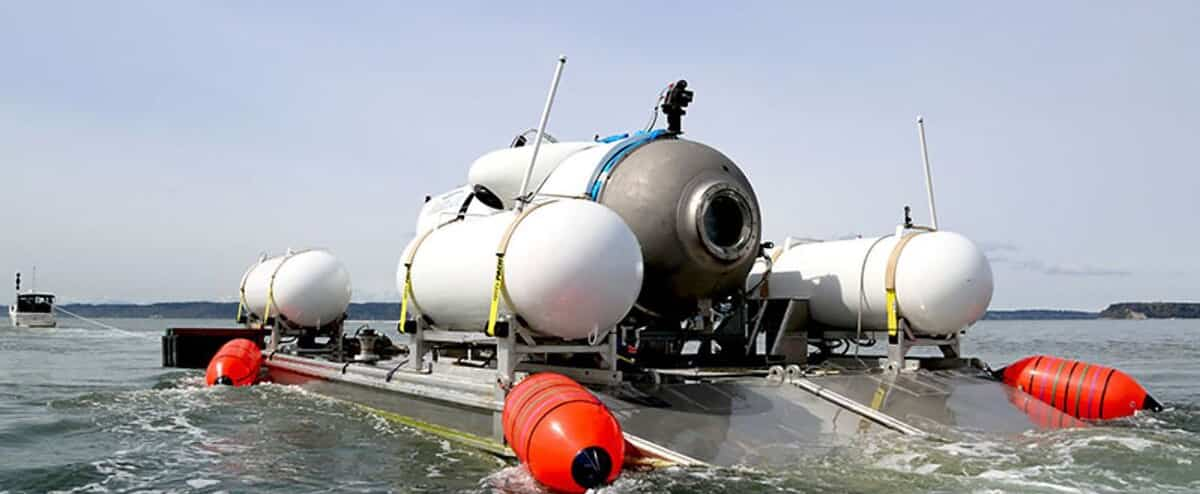There is only one day of oxygen left: the race against time to find alive the five occupants of the submersible who left to explore the wreck of the titanic is accelerating on Wednesday in the North Atlantic, but the origin of the noises picked up underwater and which had guided the research have not been identified.
• Read also: Planes, boats, robots: the means deployed to search for the missing submersible
• Read also: “It was a suicide mission”, testifies a former passenger of the Titanic submarine
• Read also: The company of the missing submersible fired an executive worried about safety in 2018
“I can’t tell you what these noises are” detected underwater by Canadian P-3 planes in the search area on Tuesday, and which raised hopes for the armada of rescuers dispatched to the scene, said captain Jamie Frederick at midday during a press briefing in Boston, in the northeastern United States.
AFP
“Although research by ROV [véhicule télécommandé] have given negative results, they are continuing,” he added.
But time is running out. Breathable air supplies are expected to run out on Thursday aboard the Titana small deep-sea explorer from the private company OceanGate.

AFP
“We must remain optimistic and hopeful,” said Captain Frederick, although he acknowledged that the operations were made complex by the surface and depth of the search area, and the coordination between “multiple agencies and countries came to lend a hand.
- Listen to Alexandre Dubé’s interview with Sébastien Pelletier, president of the organization Quebec technical wreck divers via QUB-radio :
Two robots and a sonar-equipped ship were deployed to the area where the noises were detected to locate their source.
A French Ifremer research vessel with its robot able to dive to the wreck of the titanicwhich lies at nearly 4000 meters deep, must also be deployed.
Early Wednesday, the US Coast Guard announced the arrival of three new vessels on site.

AFP
“The location of the searches, 900 miles [1448 km] east of Cape Cod [sur la côte nord-est des États-Unis] and 400 miles [643 km] southeast of St. John’s, makes it exceptionally difficult to mobilize large quantities of equipment quickly,” explained Captain Frederick.
And the wreckage of titanic itself complicates the task.
“There is a lot of metal and different objects in the water there”, so navy experts were mobilized “to understand the science behind this noise”, explained a little earlier on CBS television the cons -Admiral John Mauger of the Coast Guard.
An American, a Frenchman, a Briton and two Pakistani-Britons plunged into the abyss on Sunday aboard the Titana submersible designed for five people and about 6.5 meters long.

Hamish Harding
AFP
Contact with the craft was lost less than two hours after its departure. Tuesday noon, the US Coast Guard had warned that there were “about 40 hours of breathable air” on board.
Since Sunday and the start of research, details implicating OceanGate have emerged, the company being singled out for potential negligence in the safety of its underwater tourism device.
A 2018 complaint seen by AFP indicates that a former executive of OceanGate Expeditions, David Lochridge, was fired after raising serious doubts about the safety of the submersible.
According to this former director of marine operations, a porthole at the front of the device was designed to withstand the pressure experienced at 1300 m depth, and not at 4000 m.
The boss of OceanGate, the American Stockton Rush, is on board his Titan.
He dived alongside a wealthy British businessman, Hamish Harding (58), of the French specialist in titanic Paul-Henri Nargeolet (77) and Pakistani tycoon Shahzada Dawood (48) and his son Suleman (19), who both also have British nationality.

Shahzada Dawood and Suleman
AFP
For $250,000, they embarked on an exploration for the remains of what was one of the greatest maritime disasters of the 20e century.
“Every hour that passes is more agonizing,” founder and director of La Cité de la Mer in Cherbourg, western France, Bernard Cauvin, who worked with Paul-Henri Nargeolet, told AFP.
“I know his professionalism, including in crisis management. Psychologically and technically he knows how to manage everything, he has experienced many others, ”he added.
THE titanic wrecked on her maiden voyage in 1912, after colliding with an iceberg, killing nearly 1,500 passengers and crew.
Since the discovery of the wreck in 1985, scientists, treasure seekers and tourists have visited it, thus maintaining the myth.
